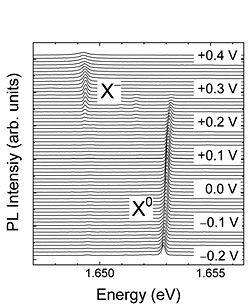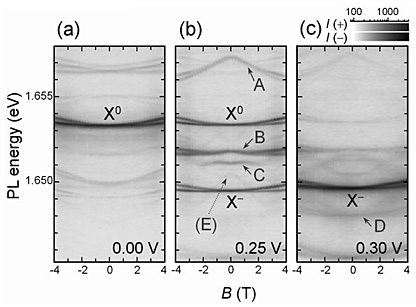Yasuhiro Tokura, and Hidehiko Kamada
Optical Science Laboratory
Spin states in semiconductor nanostructures are expected to act as quantum
information carriers in solid-state systems. One approach that allows us
to access single electron spin in semiconductor quantum dots (QDs) is to
use negative trions, which serve as an intermediary for the initialization
[1] and readout [2] of single electron spins. Most experimental studies
have focused on their lowest radiative states, however, their excited states have a rich variety of configurations because Coulomb and/or exchange
interactions between different shells are quite different from those in
the lowest shells. In this study, we investigated the magneto-photoluminescence
(PL) properties of excited trions in a charge-tunable QD [3].
Our sample consists of monolayer-fluctuation GaAs QDs embedded in an n-i -Schottky diode grown by molecular beam epitaxy. For micro-PL measurements,
the sample was cooled to 6 K in a cryostat placed in a magnetic field B, which was applied to the sample in the Faraday geometry. A Ti:sapphire
laser excited QDs within an aperture in the metal mask/electrode, and the
PL spectra were measured with a monochromator and CCD detector.
Figure 1 shows typical PL spectra obtained at B=0. Two lines labeled X0 and X- are assigned to the lowest-lying neutral exciton and negative trion, respectively.
Figure 2 shows a magnetic field dependence of polarization-resolved PL
spectra. In addition to X0 and X- emissions, we found several PL lines (labeled A〜E), most of which exhibit
much complex B dependencies. To understand the origin of these PL lines, we consider
shell and spin configuration of excited trions. From a configuration-interaction
calculation using an elliptic Fock-Darwin model, we obtained the B dependence
of trion and electron energies, and found possible assignments of shell
and spin configurations for the origin of lines A-E. We believe that the
present work opens the possibility of developing a novel scheme for the
optical control of single electron spins using the excited states of trions
in QDs.
This work was partly supported by KAKENHI (19310067).
[1] M. Atatüre et al., Science 312 (2006) 551.
[2] D. Press et al., Nature 456 (2008) 218.
[3] H. Sanada et al., Phys. Rev. B 79 (2009) 121303.
 |
 |
|||||
|
|